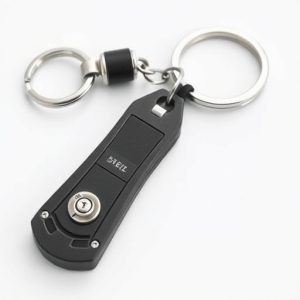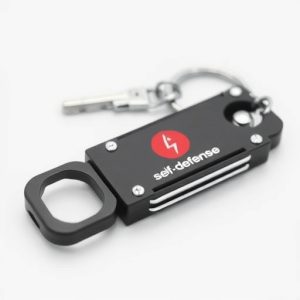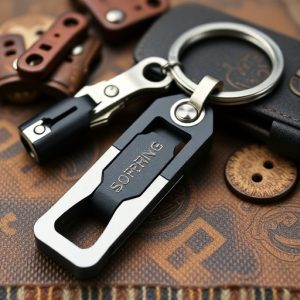Blunt Force Keychains: Protecting Yourself Within Legal Limits
Keychains with sharp or rigid edges, built-in blades, or striking capabilities are considered prohib…….
Keychains with sharp or rigid edges, built-in blades, or striking capabilities are considered prohibited weapons in many jurisdictions and can lead to legal issues. Blunt force keychains, however, offer a legal self-defense option with durable metal cores for impact absorption and various shapes catering to different styles and needs. Before purchasing, users must check their region's Prohibited Keychain Weapons List and prioritize discretion, effectiveness, and legality while selecting a keychain with reliable features designed to incapacitate attackers temporarily without causing harm.
In today’s world, personal safety is paramount. One innovative solution gaining traction is the protective keychain with blunt force capabilities, designed as a discreet self-defense tool. This comprehensive guide explores the realm of prohibited keychain weapons, their unique design and functionality, and crucial legal implications. We’ll delve into the key features to consider when choosing such a device, empowering you with knowledge about these compact yet powerful tools, including insights into the evolving Prohibited Keychain Weapons List.
- Understanding Prohibited Keychain Weapons: A Comprehensive Overview
- Design and Functionality of Blunt Force Keychains
- Legal Implications: What You Need to Know Before Carrying
- Choosing the Right Self-Defense Tool: Features to Consider
Understanding Prohibited Keychain Weapons: A Comprehensive Overview
Keychains are typically associated with convenience, serving as a practical accessory to carry essential items like keys or small tools. However, in some jurisdictions, certain keychains can be considered weapons due to their potential for causing harm when used aggressively. Understanding what constitutes prohibited keychain weapons is crucial for ensuring compliance with local laws and promoting safety.
A prohibited keychain weapon is defined by its design, functionality, and the potential for blunt force trauma. This category includes items like metal keychains with sharp or rigid edges, those with built-in blades, or any accessory that can be used to strike or penetrate the body. The ‘Prohibited Keychain Weapons List’ varies across regions, but common examples include heavy metal keychains, keychains with spikes, and those designed to look like more substantial weapons. It’s essential for individuals to familiarize themselves with local regulations to avoid unknowingly carrying such items, which could result in legal consequences.
Design and Functionality of Blunt Force Keychains
The design of blunt force keychains often reflects a delicate balance between functionality and aesthetics. These keychains are crafted with a solid metal core, typically stainless steel or aluminum, ensuring durability and strength. The ‘blunt force’ element refers to their unique ability to absorb and distribute impact energy, making them an effective self-defense tool. They come in various shapes and sizes, from sleek and modern designs to more robust, tactical styles, appealing to a diverse range of users.
Functionality extends beyond their physical attributes. These keychains are designed with a deep understanding of self-defense needs, offering a discreet yet powerful solution. Their compact size allows them to fit comfortably on a keychain, making them easily portable and accessible when needed. Moreover, some models incorporate advanced features like impact-activated mechanisms or specialized strike zones, ensuring users have a reliable tool in high-pressure situations. This design philosophy caters to individuals seeking effective self-defense options while adhering to legal constraints, as the Prohibited Keychain Weapons List varies across jurisdictions.
Legal Implications: What You Need to Know Before Carrying
Before considering carrying a protection keychain with blunt force tips, it’s crucial to understand the legal implications and potential consequences. The legality of self-defense tools like keychains varies greatly depending on your location. Many countries and states have strict regulations regarding what constitutes a prohibited keychain weapon, with some banning any object that can cause injury or death. Carrying an unauthorized device could lead to charges of illegal possession or even assault if used inappropriately.
It’s essential to familiarize yourself with the Prohibited Keychain Weapons List specific to your region. This list typically includes items designed or capable of causing significant harm, such as knives, batons, and other sharp objects. Even seemingly innocuous tools like keychains equipped with blunt force mechanisms can fall under these restrictions. Therefore, it’s imperative to check local laws and understand the potential legal ramifications to ensure compliance and personal safety.
Choosing the Right Self-Defense Tool: Features to Consider
When considering a self-defense tool, such as a keychain with blunt force capabilities, it’s crucial to choose one that aligns with your needs and complies with local laws. The Prohibited Keychain Weapons List varies by region, so understanding your area’s regulations is essential. Opt for a design that offers discreet yet effective protection, ensuring its size and weight make it easy to carry without drawing unwanted attention.
Features to look for include durable construction, a reliable locking mechanism, and a comfortable grip for easier handling in stressful situations. Some keychains come with additional tools like flashlights or window-breaking features, providing enhanced versatility. Always prioritize safety by selecting a product designed to incapacitate an attacker temporarily without causing permanent harm, respecting ethical and legal boundaries.
In light of the above discussions, it’s clear that while a protection keychain with blunt force tips can serve as a useful self-defense tool, understanding both its design and legal implications is crucial. Before carrying any such device, familiarize yourself with local laws regarding prohibited keychain weapons, including their list (Prohibited Keychain Weapons List). Always choose the right self-defense tool based on your needs, considering features like durability, ease of use, and legality. Remember that while these keychains can provide a sense of security, they are not a substitute for proper training in self-defense techniques.


